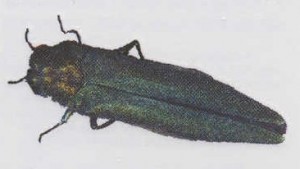 On December 1, the House Oversight Committee, Subcommittee on Interior, held a hearing on invasive species. This hearing was apparently held at the request of the ranking Democrat, Brenda Lawrence of Michigan. Ms Lawrence is most concerned about aquatic invaders in the Great Lakes. Chairwoman Cynthia Lummis is from Wyoming, so her focus is on invasive plants on western rangelands.
On December 1, the House Oversight Committee, Subcommittee on Interior, held a hearing on invasive species. This hearing was apparently held at the request of the ranking Democrat, Brenda Lawrence of Michigan. Ms Lawrence is most concerned about aquatic invaders in the Great Lakes. Chairwoman Cynthia Lummis is from Wyoming, so her focus is on invasive plants on western rangelands.
Chair Lummis opened the hearing, but left promptly. Other subcommittee members who were present for varying lengths of time were Paul Gosar (R-AZ), Ken Buck (R-CO), Gary Palmer (R-AL), Brenda Lawrence (D-MI), and Stacey Plasket (D-USVI) ; from full committee: Will Hurd (R-TX).
The witnesses were the newly appointed executive director of the National Invasive Species Council (NISC), Jamie Reaser; the president of the Reduce Risk from Invasive Species Coalition (RRISC), Scott Cameron; Dr. George Beck of Colorado State University, representing the Healthy Habitats Coalition (HHC); and Dr. Alan Steinman, expert on aquatic invaders from Grand Valley State University in Michigan.
This hearing followed those in past years that had been stimulated by the HHC. Both HHC and Congressional members expressed great frustration that the federal government is not putting sufficient effort into stopping or reversing the spread of invasive plants on western rangelands.
The December hearing – like its predecessors – focused the criticism on NISC. I think this focus is misguided. NISC has no independent authority or power; it was created to coordinate agencies’ actions, not to substitute for them. Its staff lack sufficient rank to tell agencies what to do.
In § 4 of Executive Order 13112, NISC’s duties are listed as providing national leadership through (a) overseeing implementation of this order, seeing that Federal agencies’ activities are coordinated, complementary, cost-efficient, and effective, …; (b) encouraging planning and action at local, tribal, State, regional, and ecosystem-based levels …; (c) developing recommendations for international cooperation …; (d) developing, in consultation with the Council on Environmental Quality, guidance to Federal agencies pursuant to the National Environmental Policy Act (NEPA)…; (e) facilitating development of a coordinated network among Federal agencies to document, evaluate, and monitor IAS impacts …; (f) facilitating establishment of an … information-sharing system …; and (g) preparing a national Invasive Species Management Plan every two years.
NISC has fallen far short of these requirements. It has not succeeded in developing guidance on NEPA – at least in part because CEQ has not cooperated. Most glaringly, NISC has issued only two Management Plans over 15 years — the most recent in 2009. All Members at the hearing complained to Reaser about this failure. Members see the Plan as key to setting priorities and ensuring that funds are well-spent.
All Members seemed to think that NISC actually should carry out on-the-ground activities and direct agencies’ priorities. Some want NISC to overcome federal agencies’ alleged foot-dragging in helping local groups eager to attack local problems, or to pressure Native American tribes to cooperate.
While I share the critics’ frustration about federal agencies’ inaction, I believe the productive approach is to apply pressure on – and where deserved, support for – those who have the authority and power to act, but who often choose not to.  These are:
These are:
• heads of agencies and departments, especially the secretaries of Agriculture and Interior and their Under and Assistant secretaries;
• the President;
• budget staffs of these and other relevant agencies;
• the Office of Management and Budget;
• Members of the Congressional appropriations committees.
If these people think that dealing with invasive species is politically important, they will do so. If they don’t hear from their constituents about invasive species, they will focus on other issues.
At the hearing, Scott Cameron, of RRISC, said that what is missing is commitment at the Assistant/Under Secretary Level. Such a commitment would both drive coordination among agencies at headquarters and provide “cover” for regional staff trying to work together. He feels that a new Management Plan is useful but not sufficient. Scott made several recommendations intended to raise the political visibility of invasive species issues:
1) NISC submit annual work plan to Congress – he thought this would get political level attention in the departments;
2) NISC serve as forum to coordinate with regional governors’ associations;
3) NISC create national network of regional early detection/rapid response efforts;
4) NISC serve as forum for regional officials of land-managing agencies to coordinate and work together – this might succeed in getting attention of agency leadership and OMB;
5) NISC ensure coordination of priorities and approaches by member agencies at headquarters level; and
6) NISC evaluate best practices by other governments, propose their adoption by the United States.
Dr. Beck, of HHC, reiterated his constituency’s complaint that there has been little progress on invasive species problems despite three decades of effort. He blamed the lack of leadership by NISC – without saying how staff can “lead” the political appointees who head agencies! He called – again – for abolition of NISC and transfer of its $1 million budget to “on the ground” programs. Beck also decried inconsistencies in agencies’ budgets, lack of collaboration with states and local groups in setting priorities, and NEPA having become an excuse to avoid taking action.
HHC has promoted introduction of bills in both the House and Senate – H.R 1485 & S. 2240 – which would require:
• strategic planning;
• cooperation with states;
• categorical exclusion from NEPA review for efforts to protect high-priority sites;
• 5% annual reduction in weed species’ extent; and
• allocation of agencies’ invasive species funds according to the following formula: 75% for on-the-ground activity; 15% for combined research and outreach; 10% or less for administrative costs.
Of these recommendations, I think the proposed dropping of environment reviews of invasive species management programs – especially in “high priority” sites of high ecosystem values – would be a disaster. Management programs have environmental impacts, too; and some approaches cause more harm than good. For example, use of herbicides to eliminate knapweeds has sometimes resulted in takeover of the site by non-native annual grasses that are even more difficult to control.
Also, I think the proposed funding allocation is very unwise. Research and outreach often contribute enormously to control or containment of invasive species. I have been unable to get straight answers from the USDA Forest Service about how such an allocation would affect their programs – which are divided among three separate entities – Research, State and Private Forestry, and National Forest System.
HHC is very active in promoting its position – and those of us who think differently are not yet being heard in Congress.
I think there is room to work with members of the House Oversight Committee to focus more attention on the agencies’ political leadership – where it belongs and where pressure might have an effect. Rep. Lawrence seems interested in continuing efforts. Rep. Hurd of Texas asked about steps to prevent plant pest introductions (none of the witnesses knew about APHIS programs). Furthermore, a second Michigander, Rep. Dan Benisheck, and a Californian, Rep. Mike Thompson, co-chair the Invasive Species Caucus. Although none of them has yet expressed concern about tree-killing pests, given where they are from they might be persuaded to engage.
At present, the only Congressional champion for effective invasive species programs – especially as regards tree-killing pests – is Senator Leahy of Vermont. He has helped prevent further cuts in budgets for APHIS and USFS. We need more friends in Congress.
I urge you – and your friends! – to contact your Representatives and Senators to explain how invasive species are damaging important ecological and economic resources in your state. Ask them to work with their colleagues to support and improve federal programs aimed at preventing new introductions, containing species already introduced, and developing effective methods to reduce pests’ impacts and restore native forests.
Posted by Faith Campbell
